The Valencia old town (Ciutat Vella) perfectly blends medieval charm with modern vibrancy, offering visitors a mesmerizing journey through time. Wander through the historic center of Valencia, centuries-old architecture and winding streets, and see the Roman, Moorish, and Christian influences that have shaped this Mediterranean city. This ancient quarter remains the cultural and historic heart of the city, where every corner reveals a new story or surprising fact waiting to be discovered.
Getting Oriented in Valencia’s Historic Center
The old quarter of Valencia sits within the boundaries of the former medieval walls, where the ancient Turia River once flowed. Today, this historic core contains several distinct neighborhoods, each contributing its own unique character to the tapestry of Valencia’s history. The entire historic center is remarkably walkable, though the medieval layout means streets twist and turn unexpectedly, creating an enchanting labyrinth of discovery. While maps are helpful, sometimes the best experiences come from simply wandering these ancient pathways.
18 Essential Places to Visit in Valencia Old Town
Valencia Cathedral (La Seu)
This architectural masterpiece stands as a testament to Valencia’s rich religious heritage, combining Gothic, Romanesque, and Baroque styles in magnificent harmony. Construction began in 1262 on the site of a former mosque, and today visitors can explore its numerous chapels, including the famous Holy Grail Chapel, which houses what many believe to be the actual Holy Chalice. The cathedral’s octagonal Miguelete Tower, standing 51 meters tall, offers the most spectacular panoramic views of the historic district. Visit early morning to avoid crowds and catch the best light for photographs. The cathedral is open daily from 10:30 AM to 6:30 PM, with guided tours available in multiple languages.
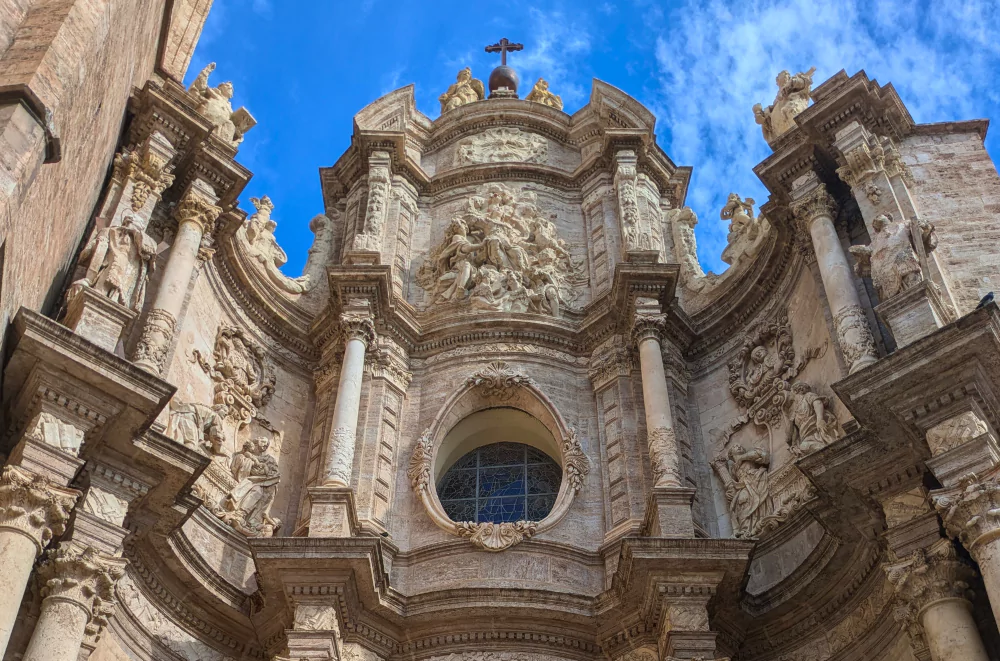
Basilica de la Virgen
This 17th-century baroque church holds a special place in Valencian hearts as home to the city’s patron saint. The basilica’s distinctive dome features breathtaking frescoes that can be best appreciated using the cleverly placed mirror on the floor – a unique architectural feature that saves visitors from neck strain. The building’s ornate façade tells biblical stories through intricate stone carvings, while the interior’s golden altar and detailed chapels showcase the wealth and devotion of historical Valencia. Time your visit for early afternoon when sunlight streams through the stained glass windows, creating magical light effects.
Church of San Nicolas
Often called Valencia’s Sistine Chapel, this recently restored church showcases some of the most impressive baroque frescoes in Spain. The painstaking restoration, completed in 2016, revealed vibrant colors and intricate details that had been hidden under centuries of grime. The church combines Gothic structure with baroque decoration, creating a stunning visual experience. The frescoes cover over 2,000 square meters and narrate the lives of Saint Nicholas and Saint Peter Martyr. Professional guides are available to explain the complex iconography and historical significance of this architectural gem.
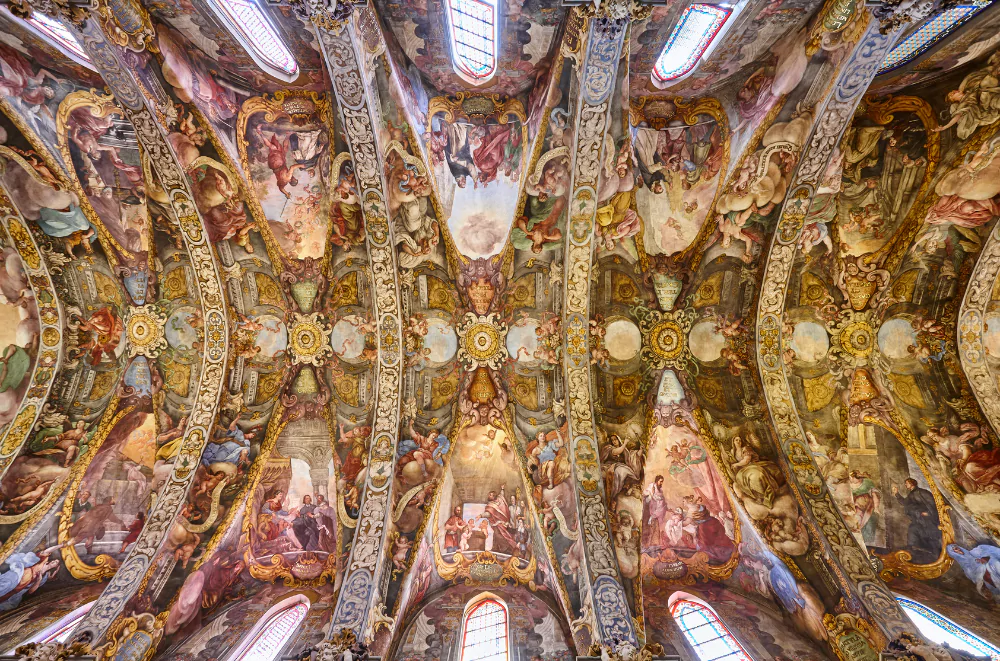
Plaza de la Virgen
Standing at the heart of Roman Valencia, this stunning square occupies the site of the ancient Roman forum. Today, it serves as the city’s social center, surrounded by the Cathedral, Basilica, and government palace. The central fountain depicts the River Turia and its eight irrigation channels that have nourished Valencia’s famous huerta (farmland) for centuries. The plaza comes alive in the evening when locals and visitors gather at outdoor cafés to enjoy traditional horchata and people-watch. During festivals, particularly Las Fallas, this square becomes the focal point for ceremonies and celebrations.
Plaza de la Reina
One of Valencia’s most beautiful squares serves as a central meeting point and offers unparalleled views of the cathedral’s Miguelete Tower. Recently renovated, the plaza now features expanded pedestrian areas, elegant seating, and carefully preserved historic elements. Traditional cafés line the square, serving everything from authentic Valencian paella to innovative modern cuisine. The square’s strategic location makes it an ideal starting point for exploring the Valencia old town, with tourist information services readily available. Visit at sunset when the cathedral’s stone takes on a golden hue and the café terraces fill with locals enjoying traditional aperitivos.
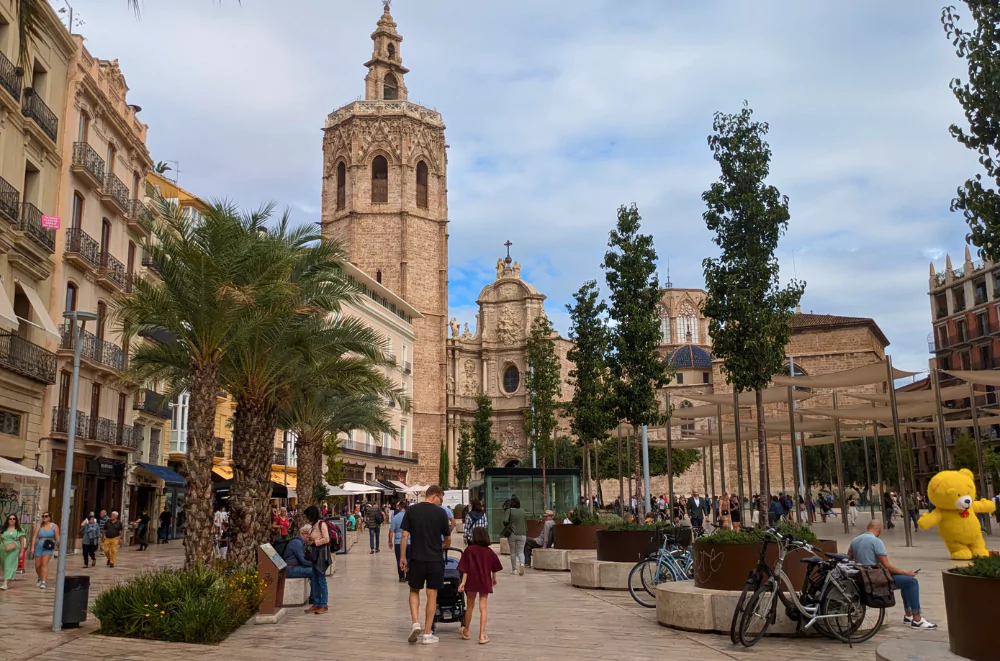
Central Market (Mercado Central)
This art nouveau masterpiece stands as one of Europe’s oldest continuously operating food markets, housed in a stunning modernist building completed in 1928. The vast space covers 8,000 square meters and features over 300 stalls beneath a dome adorned with stained glass and colorful tiles. The market’s iron structure combines functionality with beauty, while its central dome rises 30 meters high. Visit in the morning when local chefs source their ingredients and the atmosphere buzzes with activity. Don’t miss the fresh seafood section, the spice stalls, or the underground medieval ruins visible through glass floor panels. The market is open Monday through Saturday from 7:30 AM to 3:00 PM.
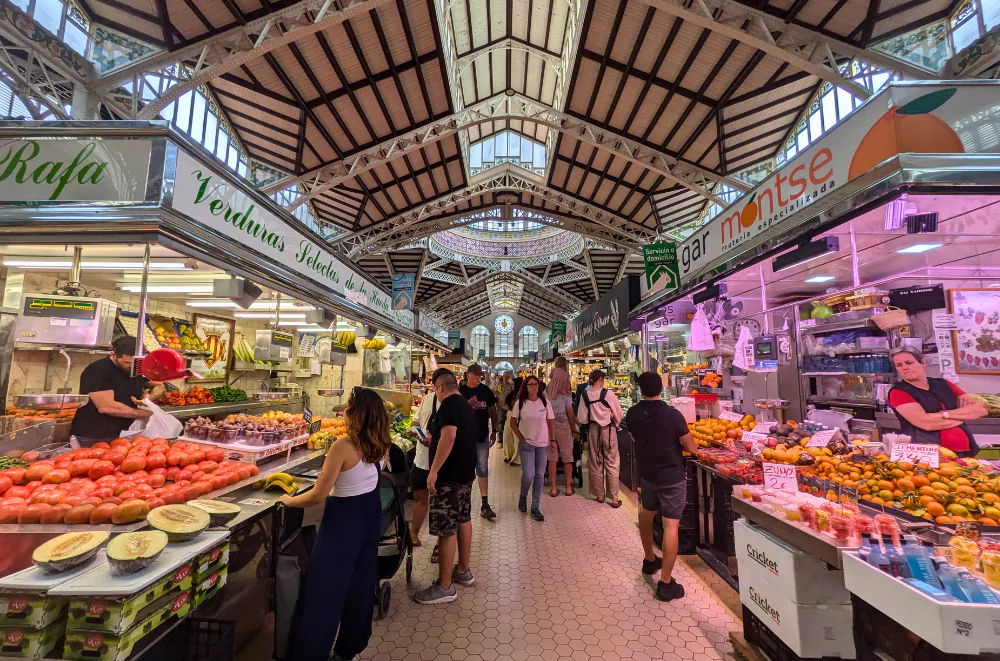
La Lonja de la Seda
This UNESCO World Heritage site represents the golden age of Valencia’s silk trade and stands as the finest example of civil Gothic architecture in Europe. Built between 1482 and 1548, the building features a main hall with twisted columns soaring to a stellar vaulted ceiling, reminiscent of palm trees reaching skyward. The Contract Hall, Garden, and Tower can all be explored, each offering unique insights into medieval commerce. The intricate stone carvings on the façade include both religious imagery and humorous gargoyles. Guided tours reveal fascinating details about the building’s role in Valencia’s maritime trade empire. Open Tuesday to Sunday, with free entry on Sundays.
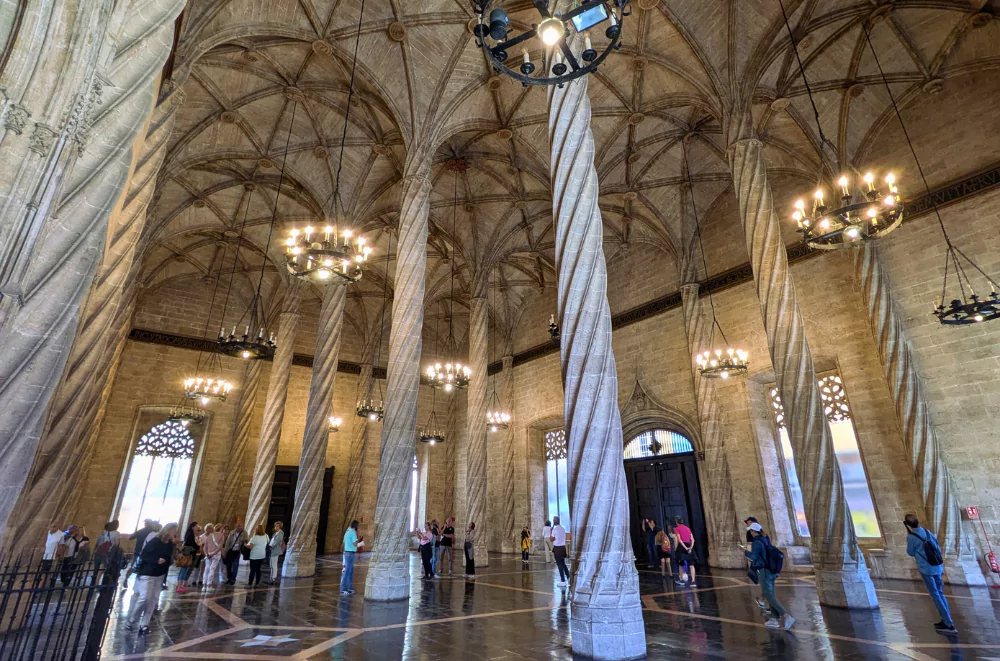
Palace of the Marqués de Dos Aguas
This stunning rococo palace houses the National Ceramic Museum but is worth visiting for its extraordinary alabaster entrance alone. The façade, sculpted in 1745, depicts the Virgin of the Rosary with allegorical figures representing Spain’s major rivers. Inside, perfectly preserved 18th-century rooms showcase period furniture, while the ceramic collection spans from ancient times to modern works by Picasso. The palace’s grand staircase and ballroom offer glimpses into aristocratic life, while the carriage museum in the basement displays ornate transportation methods of the nobility. Audioguides are available in multiple languages.
Torres de Serranos
These magnificent 14th-century towers once served as the main northern entrance to medieval Valencia and later functioned as a prison for noble criminals. Standing 33 meters high, they represent one of the best-preserved examples of Gothic military architecture in Europe. The towers’ design includes both defensive features and decorative elements, reflecting their dual role as fortress and ceremonial gateway. Climbing to the top rewards visitors with panoramic views of the old town and the former riverbed, now transformed into the Turia Gardens. The towers still serve as the official entrance point for important city ceremonies.
Torres de Quart
These battle-scarred towers bear witness to Valencia’s turbulent history, with visible cannon damage from Napoleon’s 1808 siege still evident on their façade. Built between 1441 and 1460, they served as the western gate to the city and later as a women’s prison. Unlike the more ornate Torres de Serranos, these towers emphasize military functionality with their semi-circular design and thick walls. The climb to the top offers unique views of the El Carmen neighborhood and insight into medieval defensive architecture. Information panels throughout explain the towers’ historical significance and architectural features.
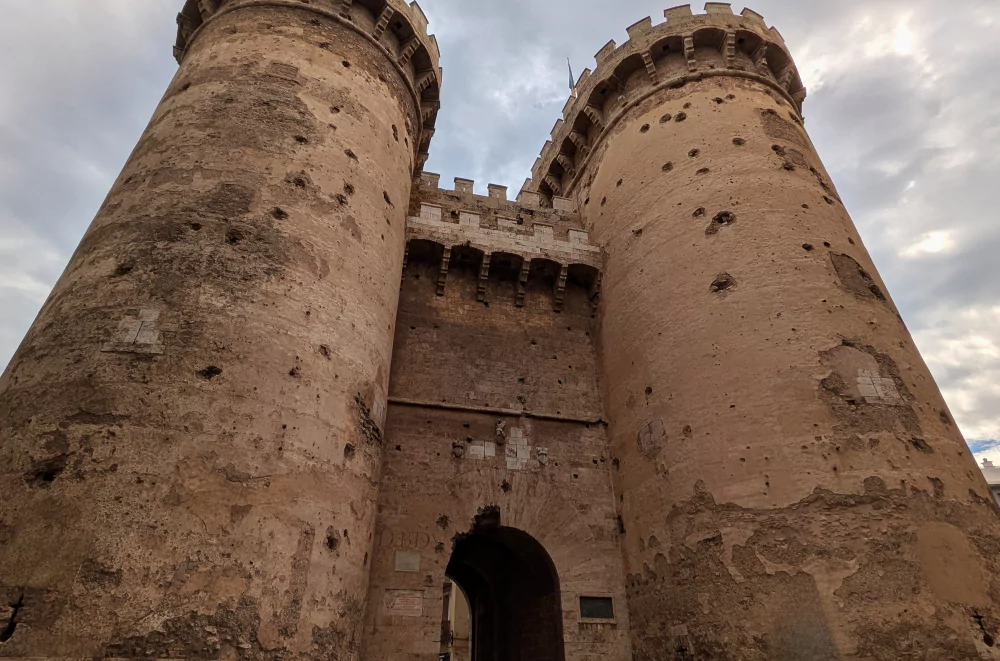
Palau de la Generalitat
This Gothic palace, serving as the seat of the Valencian regional government, showcases the power and prosperity of medieval Valencia. While many rooms are closed for official business, the Torre del Reloj (Clock Tower) and ceremonial chambers can be visited on specific days. The building’s construction spans from the 15th to 20th centuries, with each era adding its own architectural elements. The stunning Salón Dorado (Golden Hall) features an intricately carved wooden ceiling, while the chapel contains valuable Gothic altarpieces. Prior reservation is required for visits, but the impressive façade can be admired anytime from Plaza de la Virgen.
College of High Silk Art
This beautifully preserved 15th-century building tells the story of Valencia’s silk-making heritage, which once rivaled that of Asia’s greatest silk centers. The college served as the headquarters for Valencia’s powerful silk guild and still contains original weaving looms. Visitors can observe demonstrations of traditional silk-weaving techniques and explore the building’s Gothic architecture. The chapter house features remarkable frescoes depicting the silk trade’s importance to Valencia’s economy. The college’s archive contains valuable documents about the silk industry’s regulation and development throughout the centuries.
Plaza Redonda
This unique circular plaza, known locally as “El Clot” (The Hole), represents one of Valencia’s most distinctive architectural spaces. Recently restored to its 19th-century glory, the plaza’s perfect circular design features four entrances aligned with the cardinal points and a central fountain. Originally built in 1840 as a fish market, today the plaza houses traditional craft shops selling everything from handmade fans to local textiles. The innovative glass roof installed during renovation protects visitors from the elements while preserving the plaza’s open-air feeling. On Sundays, the space transforms into a lively handicraft market where local artisans display their work.
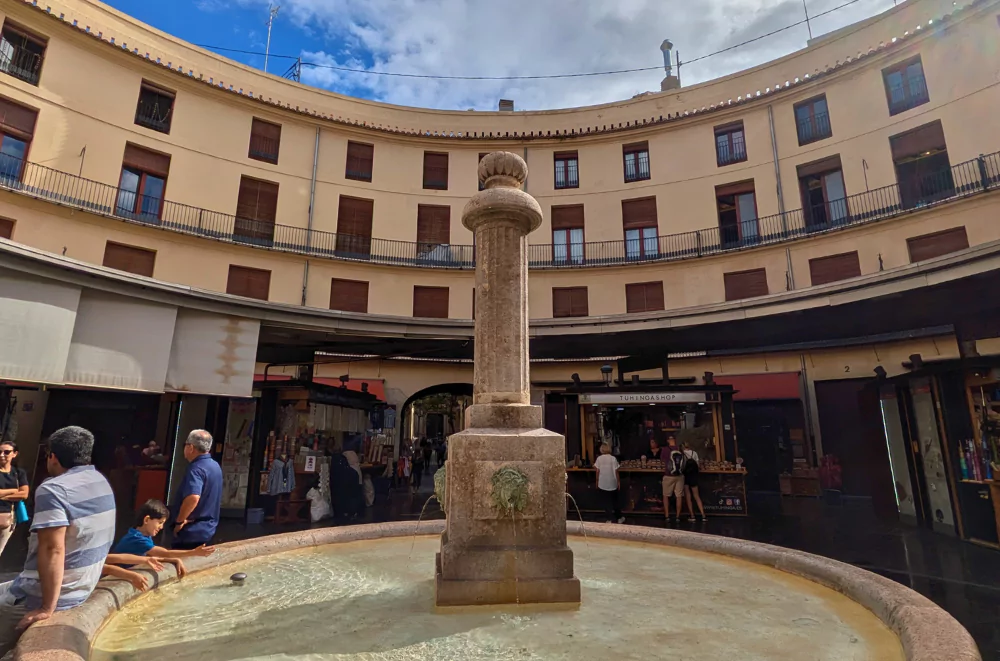
Church of San Juan del Hospital
Valencia’s oldest church, built by the Knights Hospitallers in the 13th century immediately after the Christian reconquest, contains architectural elements from multiple periods. The peaceful courtyard features Roman and medieval tombs, while the interior combines Romanesque, Gothic, and baroque elements. The church survived both the Spanish Civil War and plans for its demolition, emerging as a carefully restored monument to Valencia’s religious history. Archaeological excavations in the courtyard have revealed structures dating back to the Roman period. Guided tours explain the complex layers of history visible in this remarkable building.
Palace of the Counts of Cervellón
This restored noble palace provides fascinating insight into aristocratic life in historical Valencia. Built in the 18th century, the palace features an impressive marble staircase, period furnishings, and elaborate ceiling frescoes. The building now houses important city archives but maintains many original features, including the family chapel and grand reception rooms. The palace’s restoration revealed hidden architectural elements from earlier periods, creating a timeline of Valencia’s architectural evolution. The courtyard, with its elegant columns and fountain, offers a peaceful retreat from the busy streets.
Casa de las Rocas
This medieval building, dating from the 15th century, serves as both a museum and storage facility for the giant processional floats used in Valencia’s Corpus Christi celebration. These massive “rocas” (rocks) – actually ornate wooden carriages – have been part of city celebrations since 1373. The building features high ceilings and wide doors specifically designed to accommodate these impressive structures. Visitors can explore the permanent exhibition explaining the history and significance of Corpus Christi celebrations in Valencia, view historical photographs and documents, and examine the intricately decorated floats up close. The museum also displays traditional costumes and ceremonial objects used in the festivities.
Plaza del Carmen
This vibrant square epitomizes the bohemian spirit of Valencia’s El Carmen neighborhood. Surrounded by colorful street art, historic buildings, and eclectic cafes, the plaza serves as an outdoor living room for locals and visitors alike. Medieval palaces converted into apartments share space with contemporary murals, while traditional bars serve innovative tapas alongside classic Valencian dishes. The square comes alive at night when its numerous terraces fill with people enjoying the Mediterranean evening air. Street musicians often perform here, adding to the plaza’s artistic atmosphere. The surrounding streets contain some of Valencia’s best examples of street art, making this area a must-visit for urban culture enthusiasts.
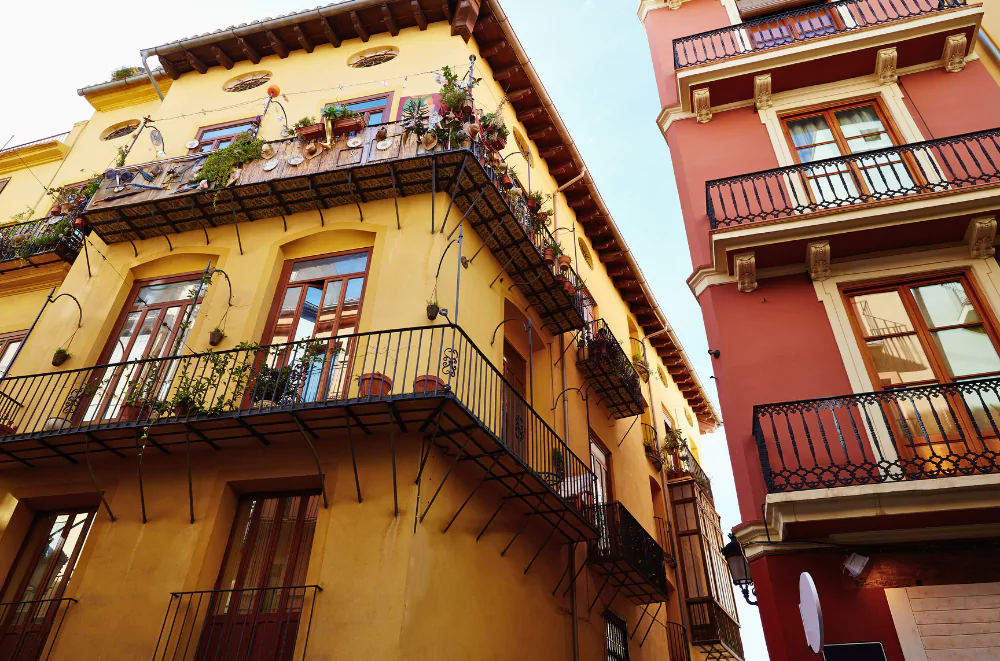
El Carmen Cultural Center
Housed in a former 13th-century Carmen (Carmelite) convent, this dynamic cultural center perfectly exemplifies Valencia’s blend of historical preservation and contemporary culture. The complex includes two Gothic cloisters, a church, and various exhibition spaces hosting contemporary art shows, performances, and cultural events. The center’s architecture tells the story of its evolution from religious institution to military headquarters and finally to cultural venue. The peaceful gardens, featuring remnants of the old city walls, provide a tranquil space for reflection. Regular workshops and educational programs make this a living part of Valencia’s cultural scene.
Tips for Exploring Valencia Old Town
The key to discovering Valencia’s historic center lies in balancing planned visits with spontaneous exploration. Early mornings offer peaceful streets and perfect light for photography, while evenings bring a lively atmosphere to the plazas and bars. The Valencia Tourist Card provides excellent value, including free public transport and museum entries. Consider joining a morning walking tour to orient yourself, then spend afternoons exploring independently. Many historic sites offer audio guides in multiple languages, providing deeper insight into Valencia’s rich history.
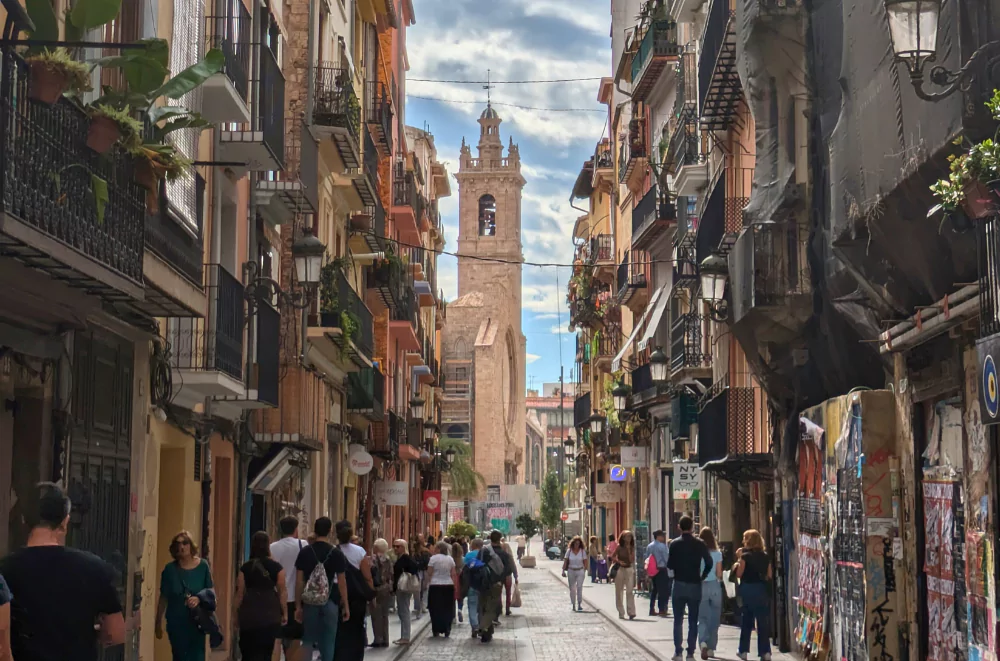
Best Time to Visit the Valencia’s Historic District
Spring and fall offer ideal conditions for exploring Valencia’s old town, with comfortable temperatures and fewer crowds. March brings the spectacular Las Fallas festival, when the historic center transforms into an open-air art gallery and party venue. Summer months, while hot, see the streets come alive in the evenings with outdoor dining and cultural events. During winter, the Valencia old town takes on a magical quality with holiday decorations and traditional celebrations. Each season offers a unique perspective on life in Valencia’s historic heart.
Where to Stay in Valencia Old Town
The historic center offers accommodation options to suit every preference and budget. Boutique hotels housed in restored palaces provide luxury with historical character, while family-run guesthouses offer authentic Valencian hospitality. Many buildings retain their original features – think exposed wooden beams and traditional tiles – while offering modern amenities. Staying within the Valencia old town means easy access to major attractions and the ability to experience the neighborhood’s transition from busy day to peaceful night.
Getting Around Valencia’s Historic Center
The medieval layout of Valencia’s old town makes walking the best way to explore its narrow streets and hidden corners. While public transportation serves the perimeter, the heart of the historic district is pedestrianized. Comfortable shoes are essential, as the cobblestone streets and occasional hills can be challenging. Bicycle rental stations are available around the old town’s edges, though walking allows for better appreciation of architectural details and spontaneous discoveries.
Safety in Valencia Old Town
Valencia old town is generally very safe, even at night. Like any tourist area, be mindful of pickpockets, particularly around busy spots like the Central Market and Plaza de la Reina. Keep these simple precautions in mind:
- Store valuables in front pockets or hidden pouches
- Be extra vigilant when taking photos or consulting maps
- Stick to well-lit streets after dark
- Keep bags zipped and close to your body in crowded areas
- Use ATMs inside banks rather than on the street
- Book accommodations in well-traveled areas of the historic district
The high number of tourists and locals enjoying Valencia’s historic center at all hours contributes to its safety. Police presence is visible around major attractions and squares, particularly during peak tourist season and festivals. Remember, the narrow medieval streets can be disorienting, especially at night. Keep a map on your phone and note major landmarks to help with navigation. Don’t hesitate to ask locals or shop owners for directions – Valencians are typically happy to help visitors.
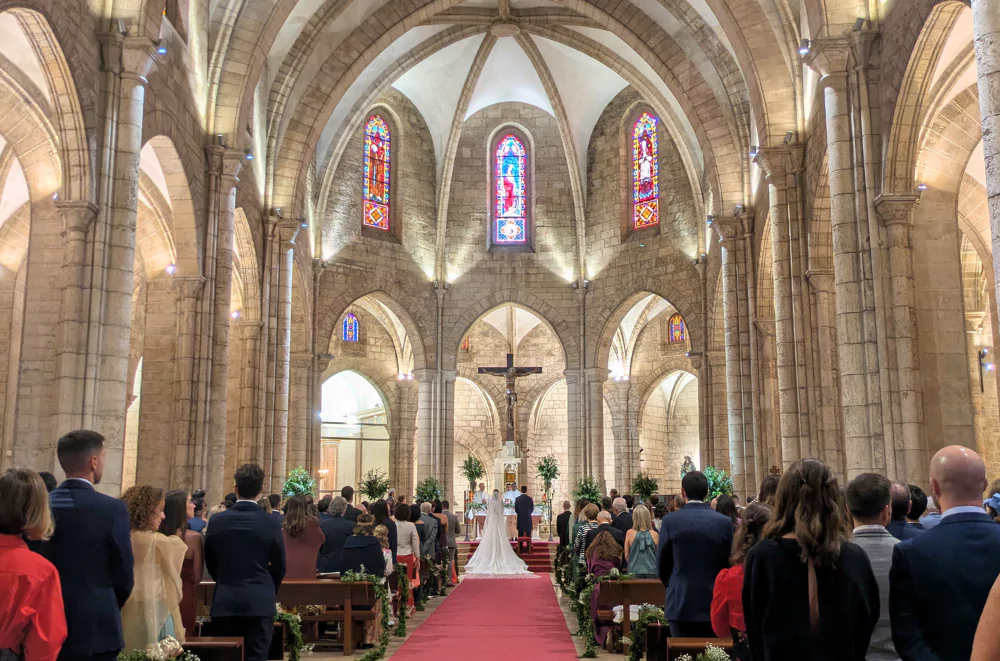
Valencia Old Town: Frequently Asked Questions
Exploring Valencia’s historic center raises many common questions. Here are detailed answers to help you plan your visit and make the most of your time in Valencia’s medieval heart.
How Long Do I Need to Explore Valencia’s Old Town?
To fully experience the historic center’s attractions, allow at least two full days. This gives you time to visit major landmarks like the Cathedral and Central Market while also discovering hidden gems and local life. If you want to include museum visits and longer meals at traditional restaurants, consider extending to three days. Many visitors find that mornings are perfect for sightseeing, while afternoons are ideal for long lunches and evening walks through the atmospheric streets.
Is the Valencia Old Town Pedestrian-Friendly?
The historic center is largely pedestrianized and extremely walking-friendly. Most streets are restricted to vehicle access, making it safe and pleasant for exploring on foot. While some streets feature cobblestones and occasional hills, the area is generally flat and manageable for all fitness levels. The compact nature of the old town means you can walk between most major attractions in 10-15 minutes.
What’s the Best Time of Day to Visit the Main Attractions?
Early morning (9:00-11:00) offers the best experience for popular sites like the Cathedral and Central Market. You’ll avoid both crowds and the midday heat, especially during summer months. Many attractions are less busy during local lunch time (2:00-4:00 PM). For photography, the golden hour before sunset creates magical lighting on the historic buildings and plazas.
Do I Need to Book Attractions in Valencia Old Town?
Popular sites like the Cathedral’s Miguelete Tower and guided tours of the Silk Exchange (La Lonja) can have long queues during peak season. Booking tickets online in advance is recommended, especially during festivals like Las Fallas or summer months. Some smaller museums and churches don’t offer advance booking but rarely have significant waiting times.
Are There Good Food Options in the Old Town?
Valencia’s historic center offers excellent dining choices for all budgets. From traditional restaurants serving authentic paella to modern tapas bars and local cafes, you’ll find plenty of options. The area around Central Market is particularly good for lunch, while the Carmen neighborhood offers trendy dinner spots. Be aware that many restaurants observe traditional Spanish dining hours, with lunch from 2:00-4:00 PM and dinner from 8:30 PM onwards.
Is Valencia’s Old Town Expensive?
Compared to other major European city centers, Valencia’s old town offers good value. While some restaurants and hotels in prime locations command premium prices, you can find affordable options throughout the area. Many major monuments have modest entrance fees, and some offer free admission on Sundays or during certain hours. The tourist card can provide significant savings if you plan to visit multiple attractions.
Can I Visit the Valencia Old Town with Limited Mobility?
Most major attractions have implemented accessibility measures, though some historical buildings have limited access due to their age and protection status. The main squares and many streets are flat and well-paved, though some narrow side streets retain original cobblestones. Modern museums like the Ceramic Museum (Palacio del Marqués de Dos Aguas) offer elevator access to all floors. Contact specific sites in advance to confirm their accessibility features.
What’s the Best Way to Get to the Valencia Old Town from the Airport?
The metro provides the most convenient connection from Valencia Airport to the old town, with lines 3 and 5 running to the city center. The journey takes about 25 minutes and stations Xàtiva and Colón are well-positioned for accessing the historic district. Alternatively, taxis offer fixed rates to the city center, and the journey takes about 20 minutes depending on traffic.
Are There Good Photo Spots in the Valencia Old Town?
The historic center offers numerous photogenic locations. The best spots include the Cathedral’s Miguelete Tower for cityscape views, Plaza de la Virgen during golden hour, the Central Market’s modernist architecture, and the colorful buildings along Calle Caballeros. The narrow medieval streets of El Carmen neighborhood also offer excellent opportunities for atmospheric photography, especially early morning or late afternoon.





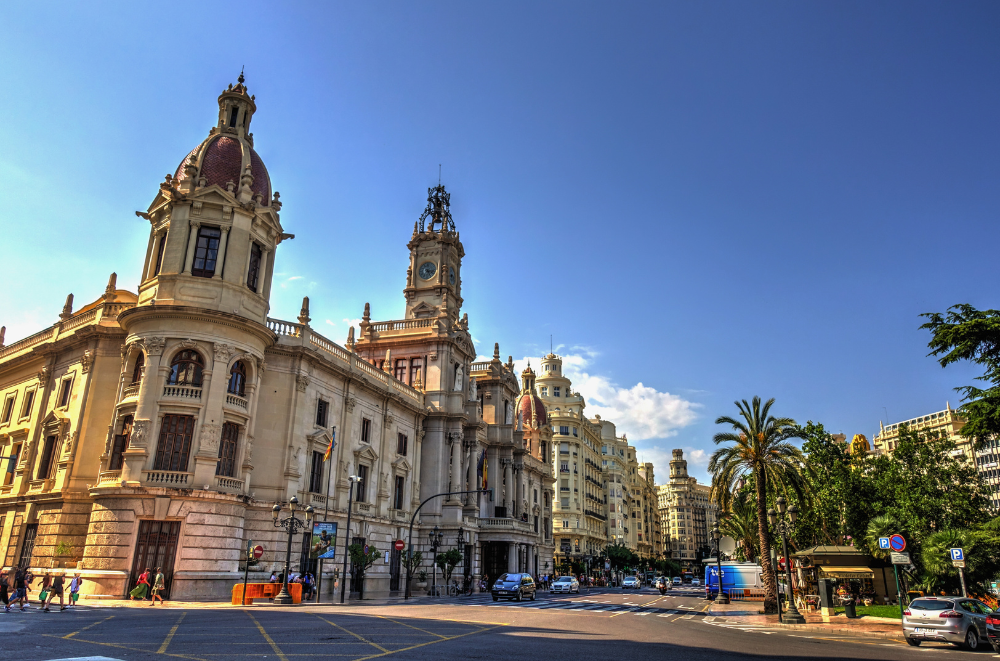

4 Responses
interesting
Thank you very much! If you have any questions about your upcoming visit to Valencia I would be happy to help
Qué alegría haber encontrado tu artículo sobre el casco antiguo de Valencia. Me encanta cómo describes la mezcla de lo medieval con lo moderno, realmente me has dado ganas de visitar.
Tengo una pregunta sobre el Miguelete: ¿vale la pena subir la torre por las vistas? Y, si hay algún horario mejor para evitar tumultos también sería genial saberlo.
Además, acabo de ver una página llamada https://world-prices.com/en/spain/prices que tiene información sobre precios en España. No estoy segura si la información es actualizada, pero tal vez podría ser útil para planificar el viaje. Gracias por el post, lo disfruté mucho. ¡Sigue escribiendo!
¡Gracias por tu comentario! Me alegra que hayas disfrutado mi artículo sobre Valencia. Sobre el Miguelete, definitivamente vale la pena subir por las vistas panorámicas. Para evitar multitudes, recomiendo ir temprano por la mañana o en días laborables. Gracias por compartir el recurso sobre precios en España, seguro será útil para otros viajeros. ¡Espero que disfrutes Valencia cuando la visites!